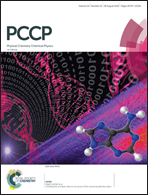Charge–dipole interactions in G-quadruplex thrombin-binding aptamer†
Abstract
DNAs form various structures through hydrogen-bonding, base-stacking and electrostatic interactions. Although these noncovalent interactions are known to be cooperative in stabilizing a G-quadruplex (G4) structure of DNA, we find from all-atom molecular dynamics simulations that the electrostatic charge–dipole interaction is competitive with both hydrogen-bonding and base-stacking interactions. For the thrombin-binding aptamer (TBA) forming a chair-type antiparallel G4 structure, we have examined effects of an intercalating metal ion [K+, Sr2+, Mn+: an ion having a charge of n+ (n = 1–4) with the ionic radius of K+] on structural properties and noncovalent interactions. When K+ in the TBA·K+ complex is replaced with Sr2+, guanine dipoles in the two G-tetrads are realigned toward the central metal ion, thereby distorting the planar G4 geometry. Replacing K+ with Sr2+ significantly enhances the charge–dipole interaction but substantially reduces the number of hydrogen bonds in the G-tetrads. In the case of TBA·Mn+ complexes, as the charge n increases, the charge–dipole interaction increases but both of the hydrogen-bonding and base-stacking interactions decrease. These results suggest that the charge–dipole interaction realigning guanine dipoles in the G-tetrads is not cooperative but competitive with both hydrogen-bonding and base-stacking interactions favoring the planar G-tetrad geometry. Obviously, the charge state of an intercalating metal ion is as important as the ionic radius in forming a stable G4 structure. Thus, a delicate balance between these competing noncovalent interactions makes the chair-type antiparallel G4 structure of TBA selective for intercalating metal ions.



 Please wait while we load your content...
Please wait while we load your content...